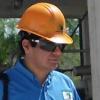Dear All,
Greetings,
Before putting my queries i just want to explain the background for the same.
I have a natural gas coming from source at 40 kg/cm2(g) & 10 Deg.C. Methane is in the natural gas is 93%.
I have a pressure reducing station where i am reducing natural gas pressure from 40 kg/cm2(g) to 9.5 kg/cm2(g).
Also note that i am using this natural gas as a fuel for water tube boiler through already provided KOD
My queries are
1. what is the temperature of natural gas at 9.5 kg/cm2(g) i.e after pressure reduction?
2. Are there in spread sheets for calculating the above temperature (I know its a Isenthalpic process) or equation to be used to calculate the same?
3. If i want to maintain the same 10 Deg.c after pressure reduction may be i need to provide the heater (I am prefer to have only steam heater). In that case please help me out how to design the steam heater, it's very much appreciable if i have spreadsheet for the same?
I am desperately looking for your help in this regard.
Thanks in advance.
Krishna Ananthaneni

 FB
FB













